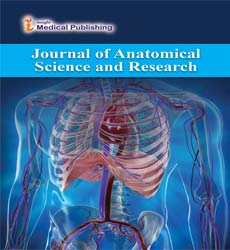Anatomy and Pathology of Pituitary Gland
Philips R. Chapman*
Department of Radiology, School of Medicine, University of Alabama, Birmingham, England
- *Corresponding Author:
- Philips R. Chapman
Department of Radiology, School of Medicine, University of Alabama, Birmingham, England
Tel: +251943962378
E-mail: pchapmansa@uabmc.edu
Received Date: April 15, 2021; Accepted Date: April 29, 2021; Published Date: May 06, 2021
Citation: Chapman PR (2021) Anatomy and Pathology of Pitutary Gland. J Anat Sci Res Vol.4 No.2:2.
Description
Pituitary organ, or hypophysis, is an endocrine organ, about the size of a pea and weighing 0.5 grams (0.018 oz) in people. It is a bulge off the lower part of the nerve center at the base of the cerebrum. The hypophysis settles upon the hypophysial fossa of the sphenoid bone in the focal point of the center cranial fossa and is encircled by a little hard cavity (Sella turcica) covered by a dural overlay (Diaphragma sellae). The foremost pituitary (or adenohypophysis) is a projection of the organ that directs a few physiological cycles (counting pressure, development, multiplication, and lactation). The transitional projection integrates and secretes melanocyte-invigorating chemical. The back pituitary (or neurohypophysis) is a projection of the organ that is practically associated with the nerve center by the middle distinction through a little cylinder called the pituitary tail (additionally called the infundibular tail or the infundibulum).
Chemicals emitted from the pituitary organ help to control development, circulatory strain, energy the executives, all elements of the sex organs, thyroid organs and digestion just as certain parts of pregnancy, labor, breast feeding, water/salt focus at the kidneys, temperature guideline and help with discomfort. The pituitary organ, in people, is a pea-sized organ that sits in a defensive hard walled in area called the Sella turcica. It is made out of two projections: front and back, with the middle of the road flap that joins the two regions. In numerous creatures, these three projections are particular. The moderate is avascular and practically missing in people. The moderate projection is available in numerous creature species, specifically in rodents, mice and rodents, that have been utilized widely to examine pituitary turn of events and function. In all creatures, the plump, glandular foremost pituitary is particular from the neural organization of the back pituitary, which is an augmentation of the nerve center.
The foremost pituitary emerges from an invagination of the oral ectoderm (Rathke's pocket). This differences with the back pituitary, which begins from neuroectodem. Endocrine cells of the front pituitary are constrained by administrative chemicals delivered by parvocellular neurosecretory cells in the hypothalamic vessels prompting infundibular veins, which thus lead to a subsequent slim bed in the foremost pituitary. This vascular relationship comprises the hypothalamo-hypophyseal entrance framework. Diffusing out of the subsequent slender bed, the hypothalamic delivering chemicals at that point tie to front pituitary endocrine cells, upregulating or downregulating their arrival of hormones.
The front projection of the pituitary can be separated into the standards tuberalis (standards glandularis) and standards distalis (standards glandularis) that comprises ~80% of the organ. The standards intermedia (the transitional projection) lies between the standards distalis and the standards tuberalis, and is simple in the human, albeit in different species it is more developed. It creates from a downturn in the dorsal mass of the pharynx (stomal part) known as Rathke's pocket. The back flap creates as an expansion of the nerve center, from the floor of the third ventricle. The back pituitary chemicals are incorporated by cell bodies in the nerve center. The magnocellular neurosecretory cells, of the supraoptic and paraventricular cores situated in the nerve center, project axons down the infundibulum to terminals in the back pituitary. This basic course of action varies strongly from that of the neighboring foremost pituitary, which doesn't create from the nerve center. The arrival of pituitary chemicals by both the front and back projections is heavily influenced by the nerve center, yet in an unexpected way.
The foremost pituitary contains a few distinct sorts of cells that combine and discharge chemicals. Generally there is one kind of cell for each significant chemical framed in foremost pituitary. With extraordinary stains appended to high-partiality antibodies that tight spot with particular chemical, at any rate 5 sorts of cells can be separated.
Chemicals emitted from the pituitary organ help control the accompanying body measures:
1. Development (GH)
2. Circulatory strain
3. A few parts of pregnancy and labor including incitement of uterine withdrawals
4. Bosom milk creation
5. Sex organ capacities in both genders
6. Thyroid organ work
7. Metabolic transformation of food into energy
8. Water and osmolarity guideline in the body
9. Water balance by means of the control of reabsorption of water by the kidneys
10. Temperature guideline
11. Relief from discomfort
Open Access Journals
- Aquaculture & Veterinary Science
- Chemistry & Chemical Sciences
- Clinical Sciences
- Engineering
- General Science
- Genetics & Molecular Biology
- Health Care & Nursing
- Immunology & Microbiology
- Materials Science
- Mathematics & Physics
- Medical Sciences
- Neurology & Psychiatry
- Oncology & Cancer Science
- Pharmaceutical Sciences
